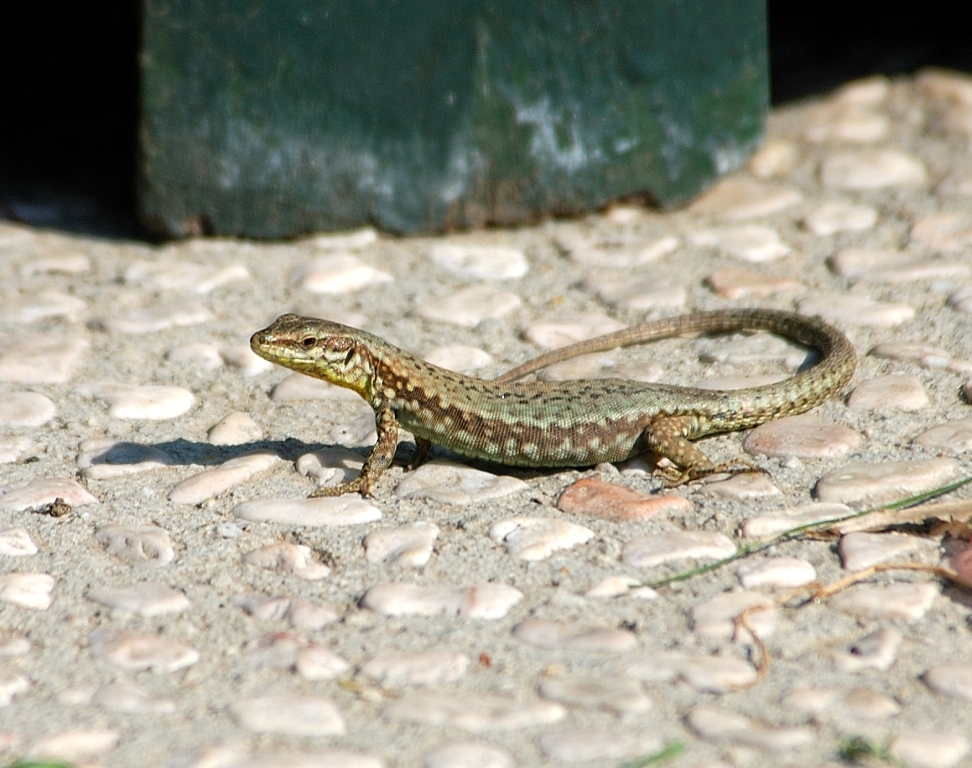| "Descrizione" by Cpt98 (2952 pt) | 2023-Nov-16 15:52 |
Review Consensus: 10 Rating: 10 Number of users: 1
| Evaluation | N. Experts | Evaluation | N. Experts |
|---|---|---|---|
| 1 | 6 | ||
| 2 | 7 | ||
| 3 | 8 | ||
| 4 | 9 | ||
| 5 | 10 |
The wall lizard (Podarcis muralis) is among the most common lizard species found in Mediterranean countries.
It hibernates between October and March and usually comes out to sunbathe, which it enjoys by standing still on low walls (hence the name) or stones.
It is a cold-blooded animal so it needs to absorb the sun's warm rays to regulate its body temperature.

It builds its burrow in the hollow of walls and soil.
It feeds on worms, insects and spiders, but does not eat ants, as do all lizards.
The female lays eggs, from two to ten, in holes in the ground or among rocks twice in a year. The eggs take two months to hatch and the mother does not hatch them, leaving them to mature in the heat of the sun.
Males defend their territory and violent hand-to-hand fighting can be seen either for dominance of an area or for the conquest of a female.
The life cycle is between 5 and 6 years.
The wall lizard is very curious and often stops to observe, so it is easy prey for many predators: birds, snakes and small mammals. It has therefore developed a unique defense technique : it can voluntarily detach the end of its tail, which it will leave in the clutches of birds of prey and escape, thus saving its life.
It always attempts to enter the house if not properly deterred.
In general, the wall lizard fears pesticides and insecticides, so if you see it in your garden, you can reasonably hope for pollutant-free.
Distribution
Podarcis muralis is native to Europe and has been introduced to North America. In Europe, its range extends from Spain and Portugal in the west to Greece and parts of the Balkans in the east, and as far north as Germany and Poland.
Habitat
As its name suggests, the common wall lizard is often found in and around human habitation, including walls, rocks, and ruins. It prefers sunny, warm environments and is adept at climbing.
Appearance
This lizard is relatively small, usually measuring between 15 to 20 centimeters in length, including the tail. It has a slender body with a pointed snout. The coloration varies but often includes shades of brown, gray, or green, with males sometimes displaying more vibrant colors during the breeding season.
Diet
Podarcis muralis is insectivorous, feeding primarily on a variety of insects and other small invertebrates.
Reproduction
The species is oviparous, meaning the females lay eggs. The breeding season typically begins in spring, and females can lay multiple clutches of eggs in a single season.
Behavior
These lizards are diurnal and are most active during the day. They are known for their agility and quick movements.
Adaptability
The common wall lizard is noted for its adaptability to various environments, which has aided its spread across different regions.
Conservation Status
Generally, Podarcis muralis is not considered endangered or threatened. However, local populations can be affected by habitat destruction and other environmental changes.
Research Interest
The species is of interest to researchers, particularly in the fields of ecology and evolutionary biology, due to its adaptability and the variation in its physical and behavioral traits across different geographical areas.
| Evaluate |

